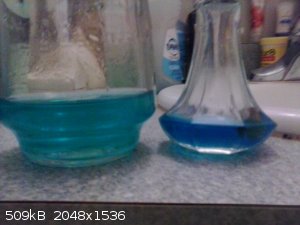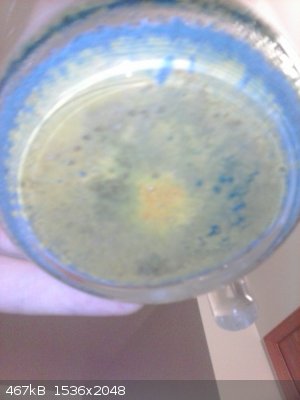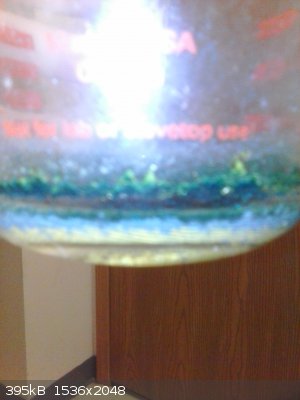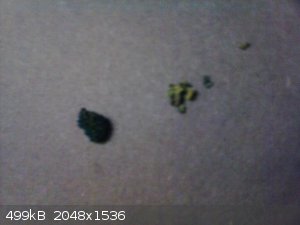bigtrevs98
Harmless

Posts: 35
Registered: 14-4-2015
Member Is Offline
Mood: No Mood
|
|
Color change in copper acetate solution
So I decided to try to make Copper(II) Acetate Crystals. I had already made boiled down some copper acetate and scraped the crystals. And I came out
with 4g of crystals. I dissolved the crystals in 25mL of water and got a dark blue solution. Much like my original copper acetate before I boiled it
down. I then put a chunk of partially nickel coated Neodymium magnet in the solution and stirred it with a home made stir plate. The solution very
rapidly started turning green. Why did it turn green? Was it due to some impurities in the magnet? Or what?
 
|
|
|
bolbol
Hazard to Others
  
Posts: 167
Registered: 3-1-2015
Member Is Offline
Mood: No Mood
|
|
Nickel ions are green colored but I am not sure if it could've gone through a displacement reaction to get some nickel into the solution.
|
|
|
byko3y
National Hazard
   
Posts: 721
Registered: 16-3-2015
Member Is Offline
Mood: dooM
|
|
Surprise: nickel reduces copper salts into elemental copper, while nickel is oxidized into a salt.
https://en.wikipedia.org/wiki/Reactivity_series
This is why people spend years learning chemistry.
You should have used at least a stainless steel. And it's a bad idea to use NdFeB magnets because they become demagnetized at relatively low
temperature. So have fun with your home made stirring plate, but go purchase a good PTFE coated stirring magnet.
|
|
|
violet sin
International Hazard
    
Posts: 1482
Registered: 2-9-2012
Location: Daydreaming of uraninite...
Member Is Offline
Mood: Good
|
|
I have not noticed copper solutions to do anything to solid nickel metal or metal plating in a rapid manner. that's kinda the whole purpose of the Ni
plate on an object. did the magnet get covered in a nice rosy plating of copper? this would indicate a reaction clearly. the electronegativity of
Cu = 1.9, Ni = 1.91( electronegativity of Xx, in google search) so not a huge difference there, not a huge reason to fight over electron. the chart
linked showed them in order, but not quantified.
|
|
|
Amos
International Hazard
    
Posts: 1406
Registered: 25-3-2014
Location: Yes
Member Is Offline
Mood: No
|
|
If you scroll down just a bit on this post, you can see some nickels that I plated in copper in the exact same way, with copper acetate solution. It appears to occur much faster
when heat is added.
If you insist on using a homemade magnetic stir bar with your hotplate, you should melt a small sheet of plastic cut from a milk jug and wrap it
around the magnet, sealing it off. But you will need to be aware that HDPE is not resistant to all of the substances that PTFE is.
Oh, and one more thing: nickel salts are carcinogenic. You might not want to get so intimate with that now-green solution.
[Edited on 4-20-2015 by Amos]
|
|
|
bigtrevs98
Harmless

Posts: 35
Registered: 14-4-2015
Member Is Offline
Mood: No Mood
|
|
Yes the magnet sat in the solution for at least 45 seconds. Stirring. It DID give the magnet a little patch of copper it seems like. And thanks Amos
for the advice but I already figured something like that out. I melted part of a sand witch baggie around it. It seems to work well. But I put the
magnet in HCl and I still get bubbles but very minute ammounts.
And update on that green solution.
the bottom looks like a layer of kinda greenish rust?
The liquid looks like blackish green
And the 3rd picture is the layers. The top layer is dry bluish crystals ondried on the glass. There is a layer of air where the solution evaporated
and the bottom you can kinda see the color of the rust
[Edited on 20-4-2015 by bigtrevs98]
 
[Edited on 20-4-2015 by bigtrevs98]
[Edited on 20-4-2015 by bigtrevs98]

|
|
|
AJKOER
Radically Dubious
    
Posts: 3026
Registered: 7-5-2011
Member Is Offline
Mood: No Mood
|
|
Quote: Originally posted by bigtrevs98  | | So I decided to try to make Copper(II) Acetate Crystals. I had already made boiled down some copper acetate and scraped the crystals. And I came out
with 4g of crystals. I dissolved the crystals in 25mL of water and got a dark blue solution. Much like my original copper acetate before I boiled it
down. I then put a chunk of partially nickel coated Neodymium magnet in the solution and stirred it with a home made stir plate. The solution very
rapidly started turning green. Why did it turn green? Was it due to some impurities in the magnet? Or what? |
I suspect having a concentrated copper acetate solution was a factor in the speed of the reaction.
Also, the reaction may have an electrochemical basis (in essence, a galvanic cell) involving a half reaction with O2. If this is the case, limiting
the presence of oxygen may, at least, slow down the nickel reaction.
By the way, I was experimenting on the electrolysis of aqueous MgSO4 (as a path to CuSO4) and noticed a profound influence of the concentration of the
starting MgSO4 solution on the speed of the reaction. Your experiment may be a similar demonstration.
|
|
|
bigtrevs98
Harmless

Posts: 35
Registered: 14-4-2015
Member Is Offline
Mood: No Mood
|
|
Another update. So there are little green crystals that formed around the rim of the solution. I scraped them off and took a picture of them next to a
Copper acetate crystal from the same solution
Still wondering what happened? D:

[Edited on 20-4-2015 by bigtrevs98]
|
|
|